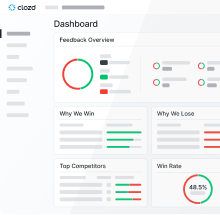Most B2B companies treat customer feedback as a postscript — a survey sent after onboarding that rarely drives action. But the period immediately following implementation is when customers form lasting impressions, encounter friction, and decide whether to renew.
Post-implementation feedback bridges that gap. It helps you catch risks early, strengthen adoption, and transform new customers into advocates. Here’s how to collect it, act on it, and tie it directly to retention outcomes.
Why Most Companies Overlook Post-Implementation Feedback (and What It Costs Them)
Driving Customer Success and Retention
Post-implementation feedback serves as a critical touchpoint in your customer journey. After a product or service is deployed, a follow-up with your clients can reveal immediate issues, prevent dissatisfaction, and foster loyalty. According to industry research, companies that actively engage in customer onboarding feedback and post-implementation follow-ups see a significant reduction in churn rates and strengthen their customer relationships.
Customer Feedback Surveys
Implementing customer feedback surveys helps gather structured insights from clients about their satisfaction levels, challenges, and future needs. This structured engagement not only gives voice to customer concerns but also embeds your business into the customer-first ethos — aligning with the strategy of organizations like Clozd, where customer feedback is a primary driver of strategic decisions.
Closing the Feedback Loop
“Closing the feedback loop” means turning insights into strategic improvements. This involves analyzing the data, implementing changes, and informing clients about adjustments made based on their input. For B2B leaders focused on retention and growth, this loop is an invaluable source of continuous improvement and innovation. It ensures that feedback doesn’t just collect dust — it actively contributes to product evolution and customer success. For a more in-depth look at this, check out our closing the feedback loop blog.
How to Collect Post-Implementation Feedback Effectively
Designing Effective Customer Experience Surveys
An effective post go-live survey should be concise, engaging, and tailored to elicit specific insights.
For customer success leaders, the goal is to connect survey responses directly to key customer success metrics — such as adoption rate, satisfaction, and time-to-value — so feedback translates into measurable outcomes.
- Open-Ended Questions: Let customers describe challenges in their own words (“What obstacles did you face after implementation?”).
- Likert Scale Questions: Quantify satisfaction to pinpoint friction.
- Specific Touchpoints: Ask about onboarding, training, and first use to identify precise improvement areas.
Utilizing Technology for Feedback Collection
Adopting AI-driven feedback analysis tools streamlines the entire process.
Clozd’s AI-powered system, for instance, automates post go-live surveys, synthesizes qualitative feedback, and surfaces decision drivers within minutes. This makes it easier to scale feedback loops while improving both data quality and response depth.
Timing and Frequency
Timing is essential. Gathering feedback immediately after implementation ensures experiences are fresh in the client’s mind, increasing reliability.
Scheduling recurring touchpoints — such as onboarding feedback sessions and 90-day check-ins — signals your ongoing commitment to customer success and retention.
How to Turn Feedback into Measurable Customer Outcomes
Prioritizing Customer Needs
Once feedback is collected, analyze and prioritize it using relevant customer success metrics to separate urgent issues from general sentiment.
- Pain Points: Identify recurring friction that impacts satisfaction or adoption.
- Success Factors: Highlight what’s working and replicate it across other accounts.
Creating Value-Driven Solutions
Turn insights into action by developing targeted improvements:
- Training Modules: Address recurring challenges revealed in onboarding and post-implementation feedback.
- Iterative Product Improvements: Feed verified customer insights directly into the product roadmap — a principle central to organizations like Clozd, where customer-driven evolution is key.
Communicating Changes to Customers
The best organizations don’t just collect data — they close the feedback loop.
Communicating updates based on customer input reinforces trust, shows accountability, and motivates customers to engage again in future feedback cycles.
Common Challenges and Best Practices for Scaling Feedback Loops
Overcoming Challenges
- Resource Allocation: Gathering and analyzing data can be time-consuming. Partnering with third-party feedback platforms provides scale and expertise.
- Insight Saturation: Avoid survey fatigue by focusing on high-impact touchpoints and pacing requests strategically.
Best Practices for Success
- Cross-Functional Collaboration: Involve sales, product, and CX teams in the feedback process to ensure alignment.
- Continuous Learning: Host regular sessions to convert insights into company-wide learning and innovation.
- Technology Integration: Use feedback analysis tools to automate insights and visualize trends in real time.
- ongoing learning and development workshops to translate feedback into organizational knowledge.
Closing the Feedback Loop for Retention and Growth
Post-implementation feedback is a cornerstone of modern customer success. By combining timely customer onboarding feedback, intelligent analysis, and a commitment to action, B2B leaders can significantly reduce churn and increase lifetime value.
For companies like Clozd, capturing the voice of the customer is not just a program — it’s a growth strategy. Through structured, ongoing feedback loops, businesses can deliver exceptional experiences, boost retention, and turn every implementation into an opportunity for continuous improvement.











.svg)


.png)








.svg)

.svg)




